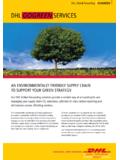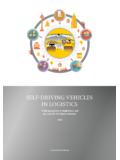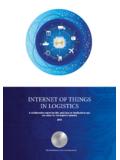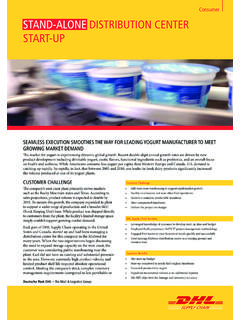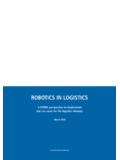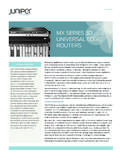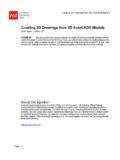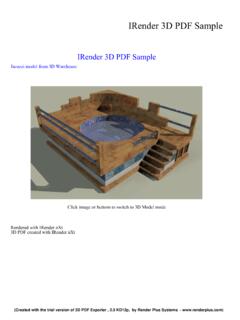Transcription of 3D PRINTING AND THE FUTURE OF SUPPLY …
1 Powered by DHL Trend Research3D PRINTING AND THE FUTURE OF SUPPLY CHAINSA DHL perspective on the state of 3D PRINTING and implications for logisticsNovember 2016 PUBLISHERDHL Customer Solutions & InnovationRepresented by Matthias HeutgerSenior Vice President Strategy, Marketing & InnovationDHL CSI, 53844 Troisdorf, GermanyPROJECT DIRECTOR Dr. Markus K ckelhaus Vice President Innovation and Trend Research, DHL Customer Solutions & InnovationPang Mei YeeVice President, Innovation, Solution Delivery & Service Management, Asia Pacific PROJECT MANAGEMENT, CONTENT, AND EDITORIAL OFFICEGina Chung, Denis Niezgoda, Rebecca BeissmannInnovation and Trend Research, Deutsche Post DHL GroupKeya Chaturvedi, Timothy Kooi Jun WenDHL Asia Pacific Innovation Center, Deutsche Post DHL GroupIN COOPERATION WITH:Science fiction is fast becoming science fact as 3D PRINTING begins to make inroads into manufacturing, from pro- duct design right through to the production floor.
2 From engineering to automotive to healthcare, companies are recognizing that 3D PRINTING presents an opportunity to do things differently . It allows us to profoundly rethink the way we create and manufacture products, as well as fundamentally reassess the design of SUPPLY our Logistics Trend Radar, we identified 3D PRINTING as one of the major disruptive trends to impact the logistics industry in the near FUTURE . We believe this is due to the immense potential for 3D PRINTING to create instant production and distribution models, essentially enabling companies and consumers alike to print complex objects within the confines of a single printer. Of course, not all products and parts can and will be 3D printed. Therefore it will be essential to understand early on where 3D PRINTING will be advantageous to your manufacturing and SUPPLY chain strategies. To support you in assessing the implications of 3D PRINTING , this DHL trend report provides insights and answers to the following key questions: What is the current state of 3D PRINTING and how is this technology being applied?
3 What competitive advantages can 3D PRINTING offer to your organization? What are the crucial success factors for the widespread adoption of 3D PRINTING ? What are the opportunities for 3D PRINTING in your FUTURE SUPPLY chain?Looking ahead, we anticipate change from 3D PRINTING that is both broad and deep, specifically in areas of spare parts manufacturing, individualized parts manufacturing, and end-of-runway 3D PRINTING services. The dialog on 3D PRINTING is building, and we hope you find this an enlightening read and look forward to discussing the exciting potential of 3D PRINTING in your SUPPLY sincerely,PREFACEDr. Markus K ckelhaus Vice President Innovation and Trend Research DHL Customer Solutions & Innovation Matthias Heutger Senior Vice President Strategy, Marketing & Innovation DHL Customer Solutions & Innovation PREFACE .. 11 UNDERSTANDING 3D PRINTING .. Introduction: Building the FUTURE with 3D PRINTING .
4 3 How does 3D PRINTING work? .. 5 Key success factors for widespread adoption of 3D PRINTING .. 72 CURRENT APPLICATIONS FOR 3D PRINTING .. 10 Individualized production .. 10 Manufacturing complex products .. 12 Decentralized and on-demand manufacturing .. 13 New services and business models .. 14 Upcoming 3D PRINTING technologies .. 153 IMPLICATIONS OF 3D PRINTING FOR FUTURE SUPPLY CHAINS .. 17 Spare parts on demand .. 17 Individualized direct parts manufacturing .. 19 Product postponement services .. 20 End-of-runway services .. 21 3D print shops for businesses and consumers .. 22 How to assess 3D PRINTING for your SUPPLY chain .. 23 CONCLUSION AND OUTLOOK .. 24 SOURCES .. 25 Table of Introduction: Building the FUTURE with 3D PRINTING 3D PRINTING , otherwise known as additive manufactur-ing , has been capturing the imagination of everyone from entrepreneurs to at-home hobbyists in recent years.
5 Today, thanks to widespread media coverage of 3D PRINTING , there is a growing surge in mainstream interest, with exciting new breakthroughs and applications being announced virtually every day (see figure 1). In the enterprise, there is also growing hype and excite-ment that 3D PRINTING can potentially revolutionize manufacturing, enabling companies to produce almost anything, layer by layer within the boundaries of a single 3D printer. Already today, leading companies eager to be first-mover winners in a 3D PRINTING FUTURE have begun to leverage this technology, demonstrating inspiring applications across a range of industries, from aviation to healthcare and even food production. By making big investments, some companies are already betting on the success of 3D PRINTING for their businesses. 1 UNDERSTANDING 3D PRINTINGU nderstanding 3D printing3 Figure 1: 3D PRINTING media hype or manufacturing reality?Major moves in 2016 alone include the Mercedes-Benz Truck announcement of its first 3D-printed spare parts service, the launch of HP s 3D PRINTING initiative, and a multimillion dollar investment by GE, BMW, and Nikon into the 3D PRINTING start-up, Carbon1, to name just a expectations and optimism for 3D PRINTING continue to increase both in the consumer and enterprise contexts, the key questions remain: Will 3D PRINTING really disrupt global manufacturing?
6 Will 3D PRINTING render traditional manufacturing factories obsolete? And consequently, will logistics volumes be disrupted?The answers to these questions depend largely on changes in economics, new technological breakthroughs, and FUTURE levels of 3D PRINTING adoption. At present, many leading industry and market analysts are making promis-ing growth predictions for 3D PRINTING . The consultancy firm McKinsey estimates that the 3D PRINTING market will grow to between $180 billion and $490 billion by Similarly, Gartner, the well-known information technology advisory company, believes that enterprise 3D PRINTING is ready to break out and achieve widespread 2 McKinsey This is illustrated in Gartner s annual hype cycle of emerg-ing technologies which shows the accelerating maturity of enterprise 3D PRINTING (see figure 2). Over the past five years, enterprise 3D PRINTING has successfully moved from being a nascent technology to reaching the cusp of the plateau of productivity, signaling that mainstream adoption is starting to take off.
7 In contrast, consumer 3D PRINTING is still at the peak of inflated expectations and will require more time before it reaches mass 3D PRINTING make sense? The economics of 3D printingUnderstanding 3D printing4 This uptick in 3D PRINTING investments and adoption can be attributed to the increasing number of companies beginning to realize, on the one hand, the possibility for new 3D PRINTING business models and services and, on the other hand, the major economic advantages of 3D PRINTING compared to conventional manufacturing traditional manufacturing, materials are usually sourced and shipped from several locations to centralized factories that develop and assemble the final product. The finished goods then pass through several steps in the SUPPLY chain, usually being stored in warehouses before delivery to stores or directly to the end-customer once an order has been PRINTING , in contrast, can greatly reduce complexity in manufacturing and holds a number of additional advantages over conventional production techniques (see figure 3).
8 A major benefit of 3D PRINTING is the ability to produce a variety of products from a single 3D printer. This reduces the number of steps in the production chain, essentially enabling companies to leverage on-demand and decentralized production concepts. As a result, potentially significant economic savings can be made on logistics and production costs. Lower number of production steps to design, prototype and manufacture highly complex and/or customized products Faster delivery time through on-demand and decentralized production strategies Lower logistics and production costs ( , reduced shipping and storage costs, potential elimination of import/export costs through localized pro- duction, elimination of new production tools and molds and costly modifications to factories) Higher sustainability and efficiency in production through using the least amount of material and energy in productionTimeExpectations3D Printing2011 Figure 2: 3D PRINTING in the Gartner Hype Cycle; Sources: Gartner (2011, 2013, 2015)Innovation TriggerPeak of InflatedExpectationsTrough ofDisillusionmentSlope of EnlightenmentPlateau of ProductivityFigure 3: Key advantages of 3D PRINTING .
9 Source: DHLC onsumer 3D PRINTING 2013 and 2015 Enterprise 3D PRINTING 2013 and 2015 Understanding 3D printing5 Companies can also find additional savings from the reduction of production waste as well as the increase of sustainable business practices through 3D PRINTING . A study by Airbus showed that by redesigning its brackets for 3D PRINTING , the company could achieve a 40% reduction in CO2 emissions over the lifecycle of the bracket and reduce the weight of the airplane by 10 kg. 3D PRINTING also enabled a 25% reduction in material waste compared to traditional casting methods (see figure 4).3 Taking these advantages into consideration, figure 5 illustrates some calculations on the economics of 3D PRINTING for everyday household items that require some customization for example, a shower head that needs to fit the size of the pipe or an iPad stand that needs to be designed to the model s exact size. For these customized printed objects, the potential savings are anywhere between eight to 80 times an equivalent retail price.
10 Consumers and businesses can make substantial savings by 3D PRINTING these objects shows that leveraging 3D PRINTING in the right product segments makes sense. It can especially provide great value where there is a high level of complexity and 3 4: Left a conventional bracket design. Right a bracket optimized for 3D PRINTING ; Source: EosITEMSRETAIL PRICE RANGECOST TO 3D PRINTS hower Head$ $ $ Organizer$ $ $ Stand$ $ $ 5: The economics of 3D PRINTING ; Source: Joshua Pearce (2013)customization in the design and production of a product as well as where there is a need for smaller batch sizes. Therefore it will be essential to understand where 3D PRINTING will be advantageous compared to traditional manufacturing and SUPPLY chain How does 3D PRINTING work?Put simply, the functions of a classic 3D printer are quite similar to those of a conventional inkjet printer. Both obtain PRINTING information from a digital file but, while inkjet printers apply ink to paper, 3D printers inject materials in successive patterns to build a three- dimensional solid object.



